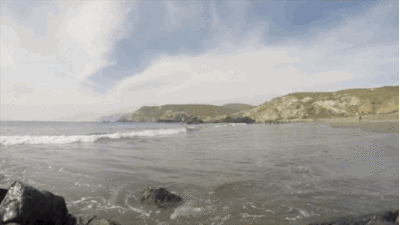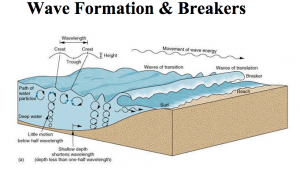
Waves start far away from the beach, out in the open water. As wind brushes up along the ocean, friction is created between the wind and the water, transferring energy from the wind to the water molecules. As the wind continues to push against the water, it can force smaller wave energy together forming larger waves. When the wave energy reaches the coast, the water starts to run into the ocean floor and is slowed down by friction. The closer the water gets to shore, the more shallow it is, causing more water molecules to come in contact with the ocean floor and slow down. As the energy moves closer to shore, the surface water continues forward at the same speed while the deep water continues to slow down. Eventually the water at the surface crashes over itself forming waves we see on the beach.
 Photo Credit: http://www.geography.hunter.cuny.edu/~tbw/ncc/Notes/chap3.landforms/oceans
Photo Credit: http://www.geography.hunter.cuny.edu/~tbw/ncc/Notes/chap3.landforms/oceans
.coastal.processes.landforms/waves/wave.formation.breakers.htm
The size of the wave depends on many different factors. First which of is the speed of the wind, the faster the wind travels the bigger the wave will be. This is due to the greater force of which the wind places on the ripples of the ocean. The second factor is the fetch, or the amount of time wind is blowing over a certain area of water. Waves will continue to get larger the longer wind blows across the water.

Larger waves tend to be formed farther from shore than smaller waves which are created right offshore. Waves that start far offshore are typically called swell waves because they have much more time to build in the open water. Large storms have the perfect conditions for forming large waves due to the amount of wind and pressure that is pushing against the ocean.
Surfers monitor the weather conditions and patterns to determine if the surf will be large or small. Here on Catalina Island the best surf comes from the windward, or the open ocean side of the island. This is due to the open ocean swell that builds up over time reaching the island as large waves. On the leeward or the channel side of the island there are little to no waves. The island acts as a wind shadow, protecting the channel from wind and therefore preventing the formation of large waves. Here at CIMI we are on the leeward side of the island, which produces little to no waves. Can you figure out where we are surfing?


